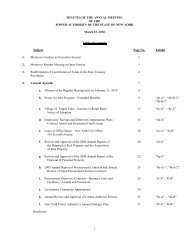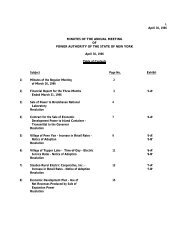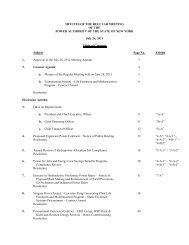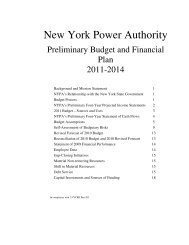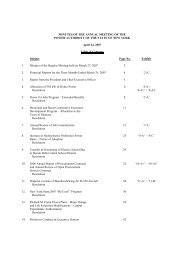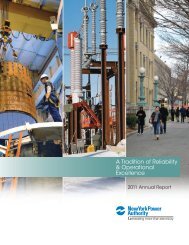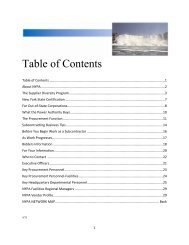July (pdf) - New York Power Authority
July (pdf) - New York Power Authority
July (pdf) - New York Power Authority
You also want an ePaper? Increase the reach of your titles
YUMPU automatically turns print PDFs into web optimized ePapers that Google loves.
needs at any point in time. Unless governed by a bilateral arrangement, the price a generator is paid and the<br />
price paid to the NYISO by an LSE purchasing energy is dependent upon the results of the bidding process<br />
and system conditions (for a discussion of certain NYISO rules having an impact on the bidding<br />
procedures, see ‘‘NYISO Mitigation Measures’’ below). A significant feature of the NYISO energy markets<br />
is that prices are determined on a location-specific basis taking into account local generating bids submitted<br />
and the effect of transmission congestion and electrical losses between regions of <strong>New</strong> <strong>York</strong> State.<br />
The <strong>Authority</strong>, being an LSE and a generator, may choose to meet its LSE load requirements by a<br />
combination of (1) bilateral arrangements, which, in the <strong>Authority</strong>’s case, would mean specified <strong>Authority</strong><br />
generation and purchased energy under contractual arrangements, linked to specified <strong>Authority</strong> loads, and<br />
(2) purchases in the DAM or the real time market. The <strong>Authority</strong>’s ownership of certain transmissionrelated<br />
rights serves to reduce uncertainty concerning congestion costs to the <strong>Authority</strong> of such bilateral<br />
arrangements and energy market transactions.<br />
Certain <strong>Authority</strong> Plant Outage Risks<br />
The NYISO administers the DAM and the real time market through which suppliers and purchasers of<br />
energy and ancillary services can sell and acquire such products. The <strong>Authority</strong> participates in these<br />
markets as both a buyer and a seller of electricity and ancillary services.<br />
Because of NYISO installed capacity reserve requirements, the <strong>Authority</strong> is required to bid into the<br />
DAM virtually all of the installed capacity of its units. The NYISO then decides which <strong>Authority</strong> units will be<br />
dispatched, if any, and how much of such unit’s generation will be dispatched. The dispatch of a<br />
particular unit’s generation depends upon the bid prices for the unit submitted by the <strong>Authority</strong>, bids<br />
submitted by other generators, the amount of generation needed by the NYISO to meet expected demand and<br />
transmission limitations. If an <strong>Authority</strong> unit is dispatched by the NYISO, the <strong>Authority</strong> receives a fixed price<br />
for each hour (the ‘‘Market Clearing Price’’), based on NYISO pricing methodology, for the energy dispatched<br />
above that designated by the <strong>Authority</strong> as bilateral arrangement generation (the ‘‘Excess Energy’’). As to<br />
the bilateral arrangement generation (the ‘‘Contract Energy’’), the <strong>Authority</strong> receives the price in its contracts<br />
with its customers (the ‘‘Contract Price’’).<br />
This procedure has provided the <strong>Authority</strong> with economic benefits from its units’ operation when<br />
selected by the NYISO and may do so in the future. However, such selections in the DAM also obligate the<br />
<strong>Authority</strong> to supply the energy in question during a specified time period, which does not exceed two days<br />
(the ‘‘Short-Term Period’’), if the unit is selected. If a forced outage occurs at the <strong>Authority</strong> plant which is<br />
to supply such energy, then the <strong>Authority</strong> is obligated to pay during the Short Term Period (1) in regard to<br />
the Excess Energy amount, the difference between the price of energy in the NYISO real time market and<br />
the Market Clearing Price in the DAM, and (2) in regard to the Contract Energy amount, the price of<br />
energy in the NYISO real time market which is offset by the Contract Price. This real time market price may<br />
be subject to more volatility than the DAM price. The risk attendant with this outage situation is that, under<br />
certain circumstances, the Market Clearing Price in the DAM and the Contract Price may be well below the<br />
price in the NYISO real time market, with the <strong>Authority</strong> having to pay the difference. In times of maximum<br />
energy usage, this cost could be substantial. This outage cost risk is primarily of concern to the <strong>Authority</strong> in<br />
the case of its 500-MW Plant because of its size, nature, and location.<br />
In addition to the risk associated with <strong>Authority</strong> generation bids into the DAM, the <strong>Authority</strong> could incur<br />
substantial costs in times of maximum energy usage in purchasing replacement energy for its customers<br />
in the DAM or through other supply arrangements to make up for lost energy due to an extended outage<br />
of its units and non-performance of counterparties to energy supply contracts.<br />
As part of an ongoing risk mitigation program, the <strong>Authority</strong> implements financial hedging<br />
2-13



